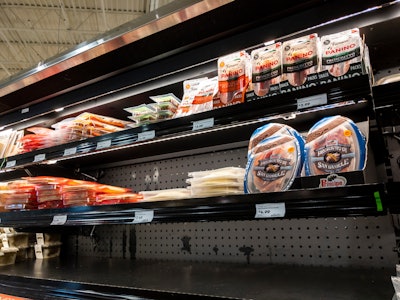
In the food industry, seasonal sales surges are a recurring challenge that require careful planning and robust logistics to manage effectively. Holidays and special occasions bring about significant fluctuations in demand that can strain supply chains. This isn’t just a seasonal blip. Beyond the obvious spikes in sales for candy during Halloween and turkey during Thanksgiving, various holidays throughout the year present unique challenges for supply chains. Cinco de Mayo usually increases demand for Latin food staples while Independence Day usually brings increased sales of traditional summer barbecue items such as hot dogs, hamburgers, and apple pie. Even hurricane season can cause food shopping spikes.
Retailers and suppliers must navigate these demand shifts to ensure that shelves are stocked, customers are satisfied, and businesses continue to operate smoothly. The key is to establish agile supply chains to get ahead of these spikes and meet peak demands. While seasonal demand surges can be predictable to an extent, managing these surges is a complex task. Food and beverage companies must rely on historical data analysis and real-time market insights to navigate the shifts. Inventory management is particularly challenging, as overstocking can lead to waste while understocking can result in lost sales.
Visibility empowers peak season agility
The interconnected nature of modern supply chains makes them highly vulnerable to disruptions, especially during peak periods. As businesses depend on global networks of suppliers and partners, identifying and mitigating risks becomes increasingly complex. Unpredictable weather conditions, transportation delays, and even unexpected shifts in consumer preference can also disrupt the most detailed plans, leading to shortages and delays that impact businesses. A recent report found 52% of companies reported lower profits from failing to meet business objectives in 2023, citing external conflicts like inflation, unforeseen global events, and internal conflicts like supplier, fulfillment, and manufacturing problems.
Unforeseen events have already had recent impacts on the food industry. The 2023 El Niño climate pattern was one of the strongest on record, and La Niña conditions are already causing summer storms to sweep the nation. Additionally, the price of cocoa has risen to an all-time high despite some stability in overall food costs. This dramatic increase is forcing suppliers and manufacturers to make tough decisions and pass along the higher costs to their customers. Finally, the recent outbreak of highly pathogenic avian influenza (HPAI), also known as bird flu, has caused some concern for beef consumers approaching the summer barbecue season, as some dairy cattle have had rare cases of the illness.
The delicate balance between meeting demand and managing costs is a critical challenge, especially for the food industry. Retailers and suppliers must work together to anticipate demand spikes and potential disruptions, as well as ensure they have the necessary inventory to meet customer expectations. Real-time visibility into inventory and shipments is a powerful tool to manage these challenges. By achieving greater control of supply chain processes both inside their companies and across their ecosystems of partners, suppliers, and customers, companies can better anticipate and respond to demand fluctuations. Connecting systems between supply chain partners provides end-to-end visibility by enabling the constant flow of real-time information between interested parties, ensuring that all participants are operating on the latest updates and communicating strategy changes with one another.
Building an agile food fortress: Strategies to conquer any sales surge
An agile supply chain is essential for navigating seasonal sales surges. Agility allows companies to adapt to sudden changes, whether a spike in demand due to a holiday or an unexpected disruption. Real-time data is the cornerstone of this agility. Many organizations are making supply chain investments to access that data, such as investing in flexible logistics networks and employing advanced analytics to forecast demand more accurately. In fact, the integration report found that businesses turned to supply chain investment to improve the customer experience (50%), foster stronger relationships with trading partners (35%), and to build resilience to supply chain disruptions (30%).
For food retailers and suppliers, leveraging real-time data to anticipate expected shopping trends is just the first step. They must also develop strategies to adapt to the unexpected.
Some steps companies can take to predict cyclical surges and unexpected shifts include:
1. Invest in real-time data systems. Implement systems that provide real-time visibility into inventory levels, shipment statuses, and sales data. These systems can alert managers to potential shortages or overages, allowing proactive adjustments.
2. Automate key processes. Automation of order-to-cash and procure-to-pay processes can significantly reduce manual errors and increase operational efficiency, helping to respond swiftly to demand changes.
3. Leverage advanced analytics. Use predictive analytics to forecast demand based on historical data, current market trends, and external factors like weather patterns or promotional activities. This enables more accurate planning and inventory management.
4. Strengthen supplier relationships. Foster strong, collaborative relationships with suppliers to ensure a steady flow of goods. Clear communication and mutual agreements on flexibility during peak periods are crucial.
Mastering the art of seasonal demand
Organizations in the food and beverage industry must take a multifaceted approach to handle seasonal surges as well as unexpected shifts in consumer demand. By achieving real-time visibility, implementing automation, and prioritizing strong supplier relationships, businesses can make fast, informed decisions to achieve more efficient operations and reduced costs. This approach also helps organizations turn potential challenges into opportunities for growth and customer satisfaction. Visibility across the supply chain ensures food organizations can manage their inventories more effectively, minimize waste while ensuring product availability, and prepare to meet the demands of holidays and beyond.


















